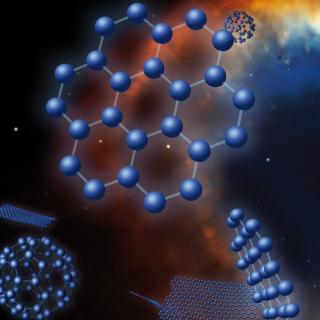Bibcode
Geisler, D.; Villanova, S.; O'Connell, J. E.; Cohen, R. E.; Moni Bidin, C.; Fernández-Trincado, J. G.; Muñoz, C.; Minniti, D.; Zoccali, M.; Rojas-Arriagada, A.; Contreras Ramos, R.; Catelan, M.; Mauro, F.; Cortés, C.; Ferreira Lopes, C. E.; Arentsen, A.; Starkenburg, E.; Martin, N. F.; Tang, B.; Parisi, C.; Alonso-García, J.; Gran, F.; Cunha, K.; Smith, V.; Majewski, S. R.; Jönsson, H.; García-Hernández, D. A.; Horta, D.; Mészáros, S.; Monaco, L.; Monachesi, A.; Muñoz, R. R.; Brownstein, J.; Beers, T. C.; Lane, R. R.; Barbuy, B.; Sobeck, J.; Henao, L.; González-Díaz, D.; Miranda, R. E.; Reinarz, Y.; Santander, T. A.
Bibliographical reference
Astronomy and Astrophysics
Advertised on:
8
2021
Journal
Citations
34
Refereed citations
32
Description
Context. Bulge globular clusters (BGCs) are exceptional tracers of the formation and chemodynamical evolution of this oldest Galactic component. However, until now, observational difficulties have prevented us from taking full advantage of these powerful Galactic archeological tools.
Aims: CAPOS, the bulge Cluster APOgee Survey, addresses this key topic by observing a large number of BGCs, most of which have only been poorly studied previously. Even their most basic parameters, such as metallicity, [α/Fe], and radial velocity, are generally very uncertain. We aim to obtain accurate mean values for these parameters, as well as abundances for a number of other elements, and explore multiple populations. In this first paper, we describe the CAPOS project and present initial results for seven BGCs.
Methods: CAPOS uses the APOGEE-2S spectrograph observing in the H band to penetrate obscuring dust toward the bulge. For this initial paper, we use abundances derived from ASPCAP, the APOGEE pipeline.
Results: We derive mean [Fe/H] values of −0.85 ± 0.04 (Terzan 2), −1.40 ± 0.05 (Terzan 4), −1.20 ± 0.10 (HP 1), −1.40 ± 0.07 (Terzan 9), −1.07 ± 0.09 (Djorg 2), −1.06 ± 0.06 (NGC 6540), and −1.11 ± 0.04 (NGC 6642) from three to ten stars per cluster. We determine mean abundances for eleven other elements plus the mean [α/Fe] and radial velocity. CAPOS clusters significantly increase the sample of well-studied Main Bulge globular clusters (GCs) and also extend them to lower metallicity. We reinforce the finding that Main Bulge and Main Disk GCs, formed in situ, have [Si/Fe] abundances slightly higher than their accreted counterparts at the same metallicity. We investigate multiple populations and find our clusters generally follow the light-element (anti)correlation trends of previous studies of GCs of similar metallicity. We finally explore the abundances of the iron-peak elements Mn and Ni and compare their trends with field populations.
Conclusions: CAPOS is proving to be an unprecedented resource for greatly improving our knowledge of the formation and evolution of BGCs and the bulge itself.
Aims: CAPOS, the bulge Cluster APOgee Survey, addresses this key topic by observing a large number of BGCs, most of which have only been poorly studied previously. Even their most basic parameters, such as metallicity, [α/Fe], and radial velocity, are generally very uncertain. We aim to obtain accurate mean values for these parameters, as well as abundances for a number of other elements, and explore multiple populations. In this first paper, we describe the CAPOS project and present initial results for seven BGCs.
Methods: CAPOS uses the APOGEE-2S spectrograph observing in the H band to penetrate obscuring dust toward the bulge. For this initial paper, we use abundances derived from ASPCAP, the APOGEE pipeline.
Results: We derive mean [Fe/H] values of −0.85 ± 0.04 (Terzan 2), −1.40 ± 0.05 (Terzan 4), −1.20 ± 0.10 (HP 1), −1.40 ± 0.07 (Terzan 9), −1.07 ± 0.09 (Djorg 2), −1.06 ± 0.06 (NGC 6540), and −1.11 ± 0.04 (NGC 6642) from three to ten stars per cluster. We determine mean abundances for eleven other elements plus the mean [α/Fe] and radial velocity. CAPOS clusters significantly increase the sample of well-studied Main Bulge globular clusters (GCs) and also extend them to lower metallicity. We reinforce the finding that Main Bulge and Main Disk GCs, formed in situ, have [Si/Fe] abundances slightly higher than their accreted counterparts at the same metallicity. We investigate multiple populations and find our clusters generally follow the light-element (anti)correlation trends of previous studies of GCs of similar metallicity. We finally explore the abundances of the iron-peak elements Mn and Ni and compare their trends with field populations.
Conclusions: CAPOS is proving to be an unprecedented resource for greatly improving our knowledge of the formation and evolution of BGCs and the bulge itself.
Related projects

Nucleosynthesis and molecular processes in the late stages of Stellar Evolution
Low- to intermediate-mass (M < 8 solar masses, Ms) stars represent the majority of stars in the Cosmos. They finish their lives on the Asymptotic Giant Branch (AGB) - just before they form planetary nebulae (PNe) - where they experience complex nucleosynthetic and molecular processes. AGB stars are important contributors to the enrichment of the
Domingo Aníbal
García Hernández